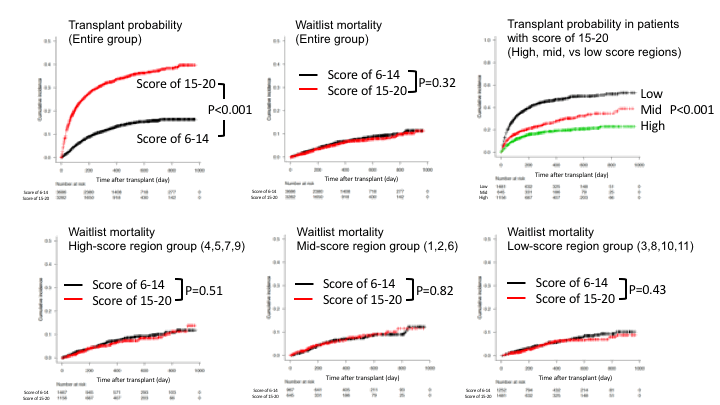Share 21 Rather Than Share 15: Balancing Transplant Opportunity without Compromising Waitlist Outcomes
1Transplant and Hepatobiliary Surgery, Henry Ford Hospital, Detroit, MI, 2Gastroenterology, Henry Ford Hospital, Detroit, MI
Meeting: 2019 American Transplant Congress
Abstract number: C281
Keywords: Allocation, Liver cirrhosis, Liver transplantation, Mortality
Session Information
Session Name: Poster Session C: Liver: MELD, Allocation and Donor Issues (DCD/ECD)
Session Type: Poster Session
Date: Monday, June 3, 2019
Session Time: 6:00pm-7:00pm
 Presentation Time: 6:00pm-7:00pm
Presentation Time: 6:00pm-7:00pm
Location: Hall C & D
*Purpose: We recently reported that, with the introduction of Meld-Na liver allocation, the score at which patients clearly benefit from liver transplant as opposed to remaining on the waiting list (survival benefit of liver transplant), has shifted from a MELD of 15 to a MELD-Na of 21 and that there may be a role for revisiting “Share 15” (Gastroenterology 2018;155:1451-1462). We hypothesize that, in a “Share 21” model, livers used for patients with MELD-Na scores of 16-20, could be shared with patients with higher scores, leading to improved waitlist outcomes in high score regions without compromising outcomes in lower score regions. The aim of this study was to evaluate waitlist outcomes in patients with MELD-Na scores of less than 21 and explore the possibility of replacing “Share 15” with “Share 21”.
*Methods: The study used data from the OPTN/UNOS STAR file. All adult patients who were registered for liver alone or liver-kidney transplant after implementation of the MELD-Na based allocation were evaluated. Waitlisted patients with initial and final scores <21 were eligible for this study. Exclusion criteria included patients with exception scores. Waitlist outcomes were compared between patients with an initial score of 6-14 and those with a score of 15-20. As a subgroup analysis, UNOS regions (1 through 11) were categorized into high, mid, and low transplant score groups and waitlist outcomes were compared. Gray test and Fine-Gray model were used to consider effects of competing risk events.
*Results: There were 6968 patients who had both initial and final scores less than 21 during the study period. Of these, 3686 had an initial score of 6-14 (group 1) and 3282 had a score of 15-20 (group 2). There were 444 and 1034 patients in groups 1 and 2 who received transplant. Overall waitlist mortality rates were similar between groups 1 and 2 (P=0.32), whereas transplant probability was significantly higher in group 2 (P<0.001). Similar waitlist mortality rates between groups 1 and 2 were observed in high (Regions 4,5,7,9), mid (Regions 1,2,6), and low (Regions 3,8,10,11) MELD-Na regions. In group 2, likelihood of transplant in the low score region group was 3-fold higher than in the high score region group (HR 3.00, P<0.001), and risk of mortality was comparable.
*Conclusions: Given the low waitlist mortality in patients with MELD-Na scores of 15-20, livers which might be used for this population could be shared with higher score patients. Share 21 may balance transplant opportunity between geographic regions without compromising waitlist outcomes nationwide.
To cite this abstract in AMA style:
Nagai S, Chau LC, Abouljoud M, Collins K, Jafri S, Safwan M, Moonka D. Share 21 Rather Than Share 15: Balancing Transplant Opportunity without Compromising Waitlist Outcomes [abstract]. Am J Transplant. 2019; 19 (suppl 3). https://atcmeetingabstracts.com/abstract/share-21-rather-than-share-15-balancing-transplant-opportunity-without-compromising-waitlist-outcomes/. Accessed December 24, 2025.« Back to 2019 American Transplant Congress

